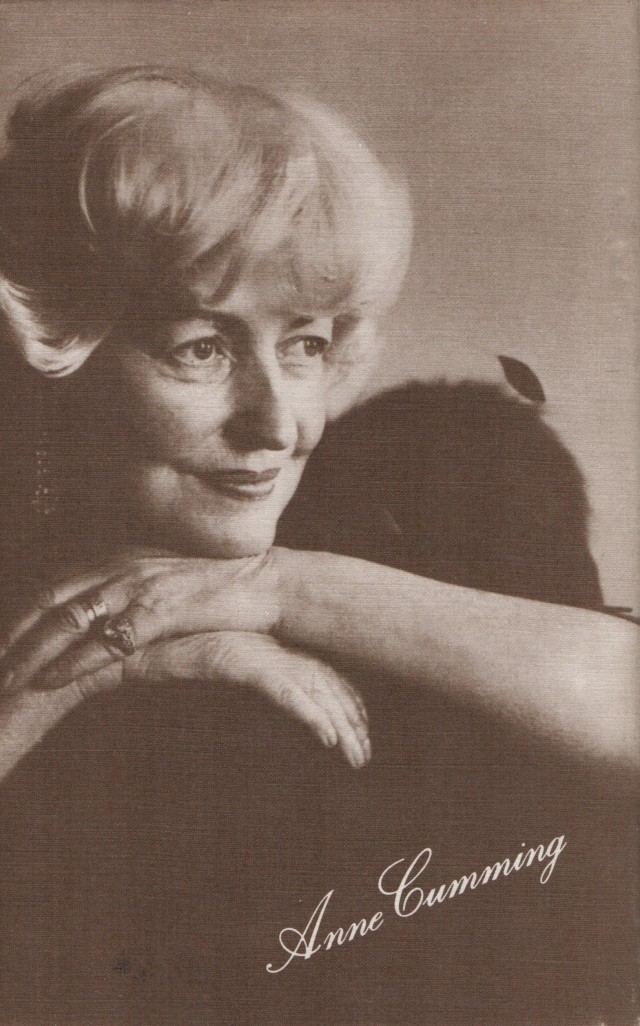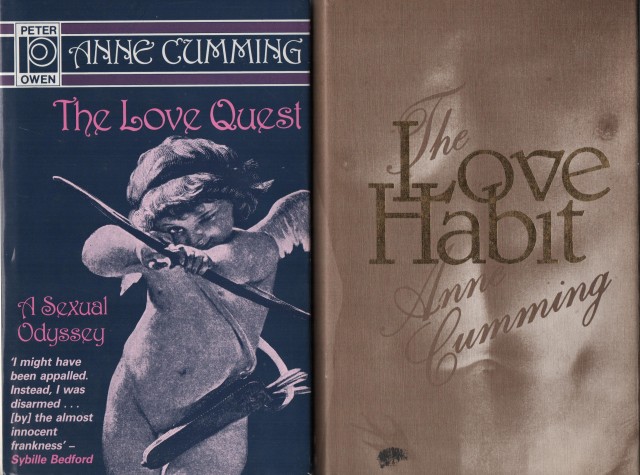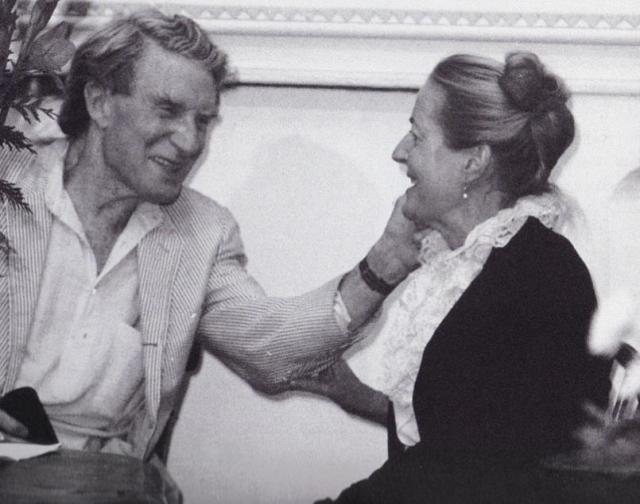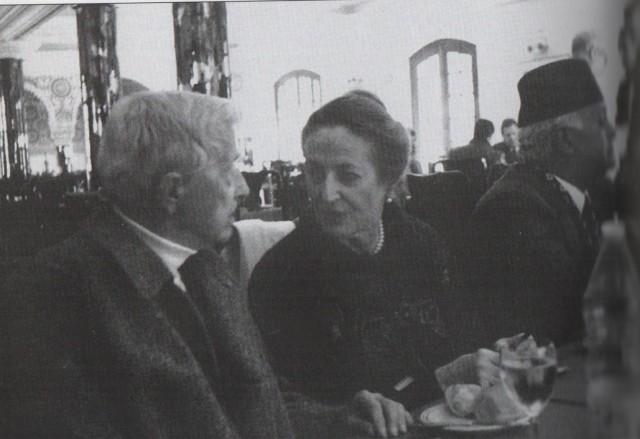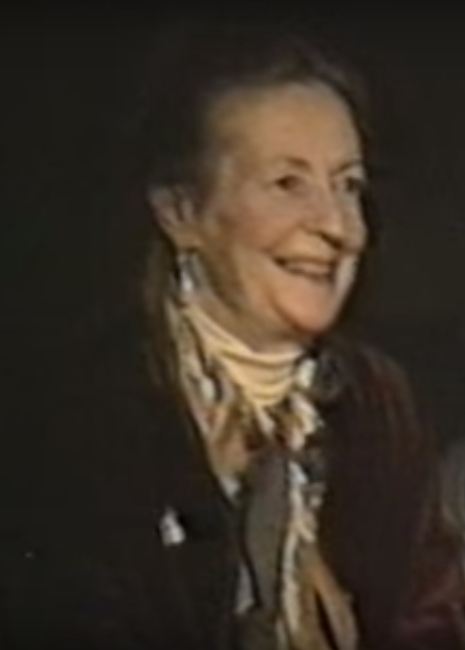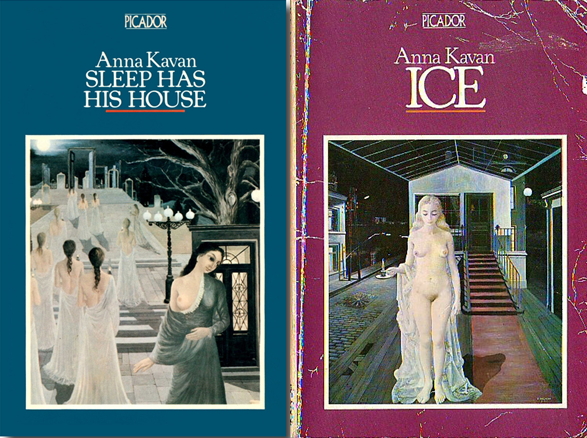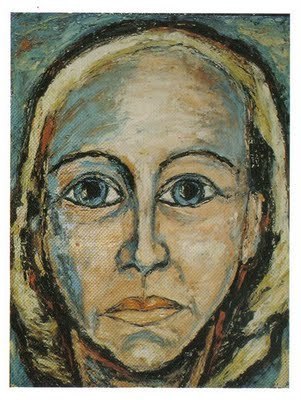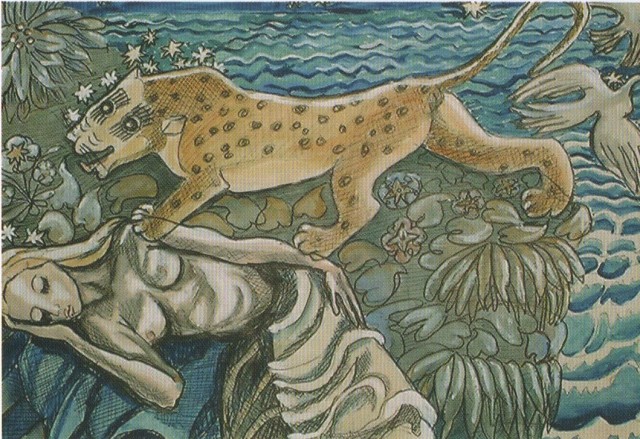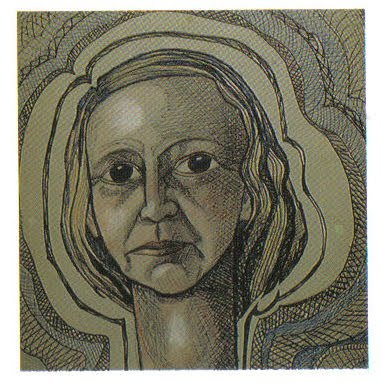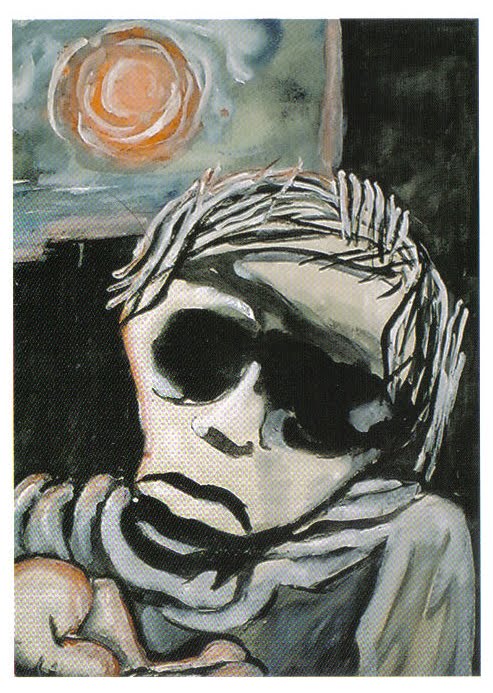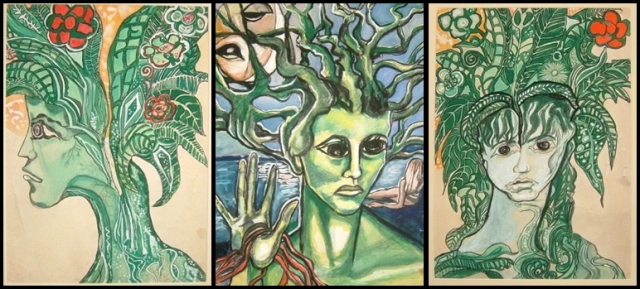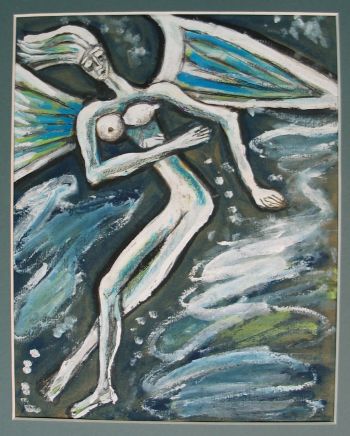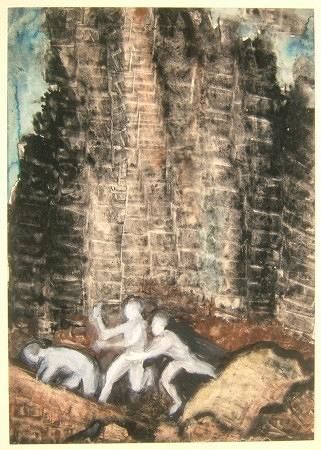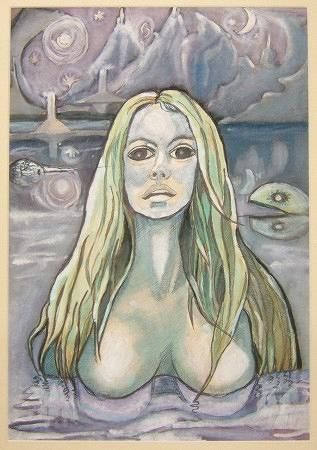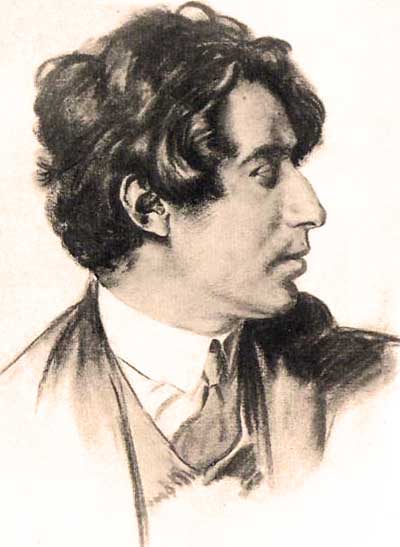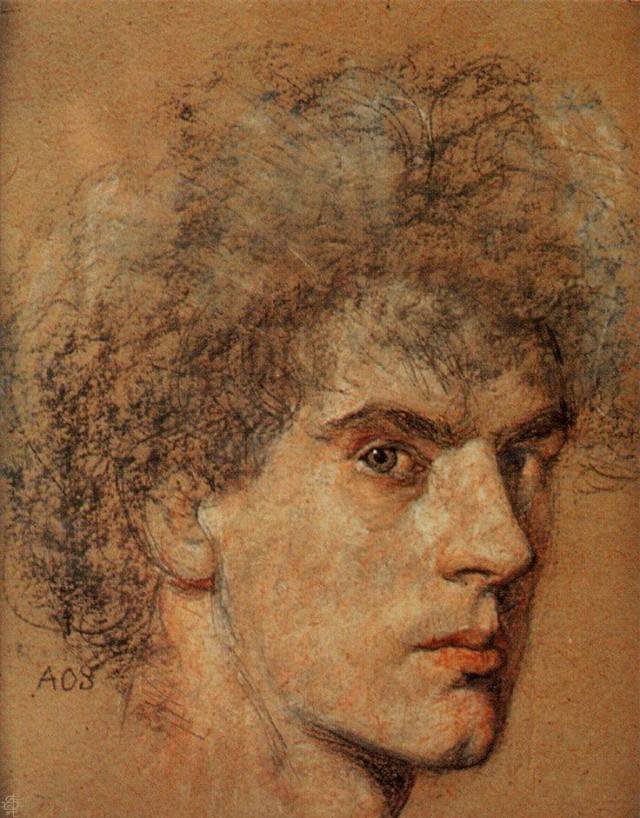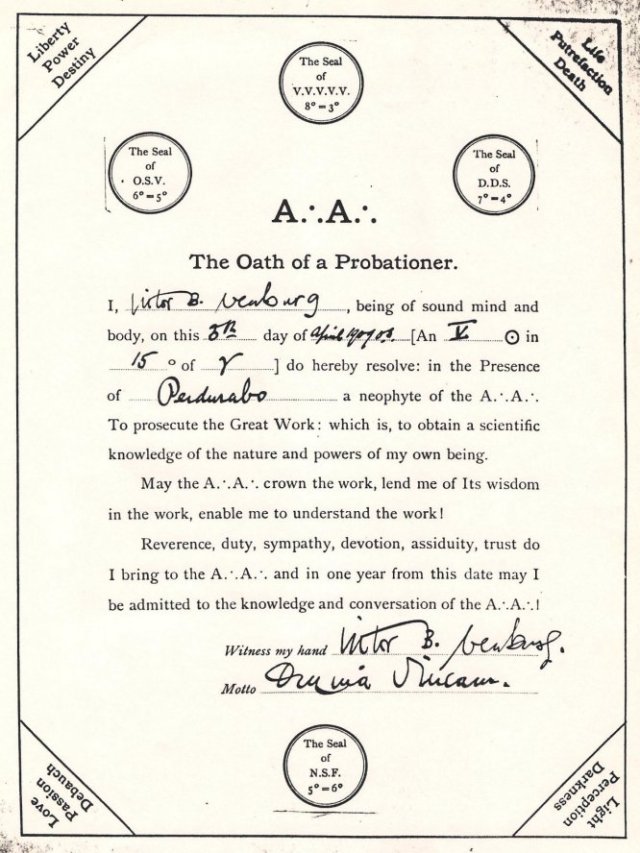⊥
A Day of Talks in Celebration of the Life & Work
of
KENNETH GRANT
(23rd May 1923 – 15th January 2011)
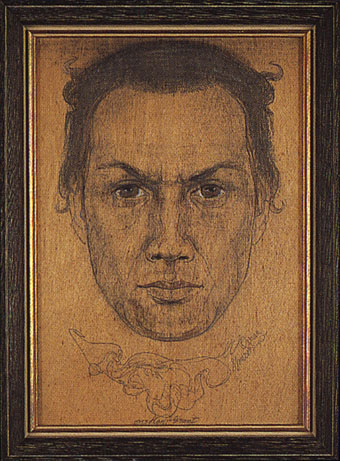
“KENNETH GRANT (1924-2011) stands out as one of the most original and prolific esoteric authors of the second half of the twentieth century and the early twenty-first century. Apart from his work promoting and publishing the works of the occultist Aleister Crowley (1875-1947) and the artist Austin Osman Spare (1886-1956), Grant is known as the creator of a particular current in contemporary occultism usually referred to as the Typhonian Tradition . . .”
Henrik Bogdan, Introduction, Kenneth Grant: A Bibliography.
“. . . The last living link to Aleister Crowley, Gerald Gardner, Eugen Grosche, and Austin Osman Spare, his legacy is yet to be fully assessed and we shall not see his like again.”
Matthew Levi Stevens, Remembering Frater Aossic, The Late Kenneth Grant.
⊥
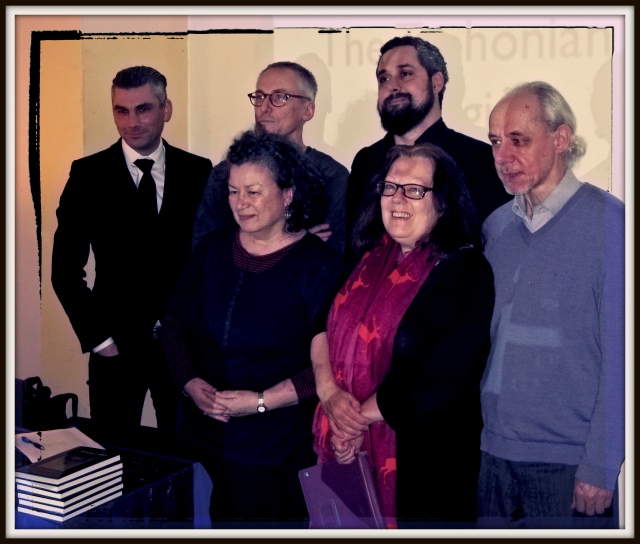 Above: Typhonian Day Speakers, 9th January 2016. L-to-R: Henrik Bogdan, Edward Gauntlett, Chris Giudice, Michael Staley; in front: Emma Doeve, Caroline Wise. [Special Thanks to Matt Baldwin-Ives for the use of his photo.]
Above: Typhonian Day Speakers, 9th January 2016. L-to-R: Henrik Bogdan, Edward Gauntlett, Chris Giudice, Michael Staley; in front: Emma Doeve, Caroline Wise. [Special Thanks to Matt Baldwin-Ives for the use of his photo.]
⊥
This past Saturday, Michael Staley & Caroline Wise of Starfire Publishing presented a Day of Talks in celebration of the many different aspects of the Life & Work of Kenneth Grant at Treadwell’s Bookshop in Store Street, London. The event also doubled as a launch for Henrik Bogdan’s Kenneth Grant: A Bibliography – substantially revised & expanded from the original 2003 edition, and profusely illustrated with many rare or even previously unseen images – as well as the new edition of Grant’s Outer Gateways, the latest reprint of the first volume of the last of his ‘Typhonian Trilogies.’
It was a great day, clearly very much enjoyed by all those both involved and attending. What follows is not so much a formal Review as a series of Notes of the Talks, accompanied by suggestive and suitable images, by way of presenting a snapshot of the day.
⊥
‘Advaita Vedanta & Occultism: The Case of Kenneth Grant’ by HENRIK BOGDAN.
After Michael Staley’s Introduction, the first Talk of the day was from Henrik Bogdan, Professor of Religious Studies at the University of Gothenberg, who has worked on a number of book relating to the Western Esotericism in general and Crowley & Thelema in particular, including Brother Curwen, Brother Crowley: A Correspondence (Teitan, 2010) and, of course, Kenneth Grant: A Bibliography.
Despite Kenneth Grant’s lifelong dedication to the Life & Work of Aleister Crowley, promulgation of the Law of Thelema, and Outer Headship of his Typhonian recension of the Ordo Templi Orientis, as he wrote in the Introduction to his memoir, Remembering Aleister Crowley (Skoob, 1991):
“My main interest was (and still is) in Oriental Mysticism. When I volunteered for the army, at the age of eighteen, it was with the expectation of being sent to India where I had hopes of finding a guru.”
It was not to be, of course, but this interest would later lead to him for a while becoming a follower of Ramana Maharshi (1879-1950), the ‘Sage of Arunachala’ and leading proponent of Advaita Vedanta, and writing a number of articles for Indian journals in the 1950s* such as Ananda Varta, The Call Divine, and The Vision.
“Advaita Vedanta asserts that Absolute Reality (Brahman) is infinite, formless, non-dual awareness, and that the supreme goal of human life is the realization that the inner self (atman) is not separate from Absolute Reality.”
Below: Sri Ramana Maharshi – “Atman is Brahman.”
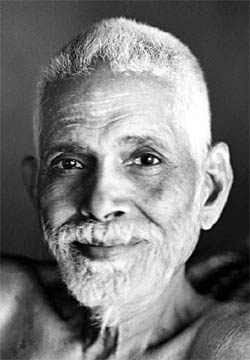
Here is Kenneth Grant’s definition of Advaita, as given in the Glossary to The Magical Revival:
“Advaita (Skt.): Lit. Not-two. The Vedantin doctrine of Non-duality, which reveals the supreme nature of Self to be One, not two or many; i.e. nothing exists apart from the Self (Atman), yet all things are forms assumed by the Self.”
All images arising and ‘bubbling up’ are aspects or masks of the Self.
Kenneth Grant saw Thelema’s pursuit of realising one’s True Will as equated to Maharshi’s essential meditation “Who am I?”
Neo-Advaita in Kenneth Grant’s work:
- The appeal of Neo-Advaita on occultism
- Focus on Experience (Gnosis)
- Universalism as a strategy of legitimacy
This focus on Eastern systems in general and Advaita in particular would not come as any surprise to those familiar with the Typhonian Trilogies, but what was perhaps more of a revelation was when Henrik began to tell us about Grant’s ‘Spiritual Crisis’ of the mid-1950s. Perhaps something of this could be anticipated from a reading of his novel, Grist to Whose Mill?, in which the narrator’s feelings regarding the clearly Crowley-inspired character ‘Ruthven Seeley’ and his legacy are strongly ambiguous, to say the least. Apparently in Spring 1953 Grant felt that he was turning away from Crowley & Thelema, back to “Oriental (especially Indian) systems of Mysticism” – going so far as to write in a letter of the 27th of March, 1953, to German Thelemite, Friedrich Lekve:
“I wish to be rid forever of any connection I may have had in the past with AC’s doctrine or practice . . . suffice it to say I have had enough.”
But by September 1955, with his article ‘Resignation’ in the Indian magazine The Call Divine, Grant had clearly overcome his conflict over Crowley, just before launching New Isis Lodge.
The notion that Western and Eastern Traditions are essentially the same are at the heart of Grant’s Typhonian Trilogies:
East contemplates ever-tranquil and immutable Shiva, “Let things take their course.”
West embraces active Shakti, via “Do what Thou wilt.”
In closing, Henrik defined the Typhonian Tradition as:
“A bricolage of Advaita, Western Sexual Magick, Surrealism, UFOlogy and Lovecraftian Gnosis, within the framework of Thelema.”
[Interestingly, Michael Staley revealed in the brief Q&A after Henrik’s Talk that even as late as the 1980s, Grant still maintained several sessions of meditation practice on a daily basis.]
*Kenneth Grant’s writings from this period were later collected and commented upon in At the Feet of the Guru.
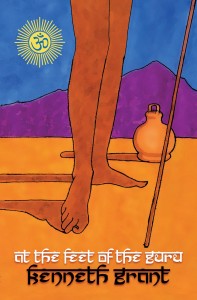
⊥
‘The Wisdom of S’lba and transmitted texts’ by MICHAEL STALEY.
Michael Staley discovered the work of Kenneth Grant in the early 1970s, soon after becoming a member of the Typhonian O.T.O. and then in 1986 launching the magazine Starfire. Since the late 1990s he became Grant’s publisher, committed to seeing all of his works into print, as well as continuing to oversee the Typhonian Order.
Michael started by defining a received text in this instance as being communication from a praeterhuman intelligence.
Examples include: Dee & Kelley, The Angelic Conversations; Crowley, The Book of the Law; and further back: Moses, The Ten Commandments; and Joseph Smith, The Book of Mormon. (One could also include Blavatsky’s Stanzas of Dzyan, Nema’s Liber Pennae Praenumbra, and an example that Kenneth Grant also gave a number of times, the mammoth and mysterious ‘Kosmon Bible’ Oahspe.)
The primary example here is, of course, Liber AL vel Legis, The Book of the Law, received by Aleister Crowley in Cairo, a chapter at a time during one hour sessions extending from Noon, 8th – 9th – 10th April 1904, dictated by AIWASS – but Michael stressed that there was a period of preparation, with Crowley performing Rites to make ready after first signs of ‘Contact’ via his wife, Rose Kelley.
The first reference to S’LBA is given in an account of a dream from 1939 (‘The Cavern Initiation’) which Grant describes in Chapter 8, ‘Initiation of Aossic’, in his Outside the Circles of Time:
“One night in 1939 I dreamed of entering a winding cavern. At each turning the darkness grew denser so that it came as a shock when, after groping around yet another turning, I was suddenly dazzled by a brilliant light . . . I saw that its source was a mysterious sigil emblazoned on the rock . . . The sigil, although unfamiliar, had for me an instant personal appeal . . . I adopted it instinctively as a secret cypher of my Magical Self . . .”
The whole text of what became known as the ‘Wisdom of S’lba’ included in Outer Gateways started as early as Grant’s dream in 1939, was elaborated during his time with Crowley and then Austin Osman Spare, and then finally reified through New Isis Lodge.
In Beyond the Mauve Zone, Grant describes finally meeting Crowley, when he was coming towards the end of his stay at The Bell Inn, Aston Clinton. It was December 1945, and as they shook hands for the first time the song ‘Shine On Harvest Moon’ was playing on the radio in the background. Grant showed Crowley some of the first fragments of S’lba, and although he was initially “positive” he then sensed a threat to his authority . . .
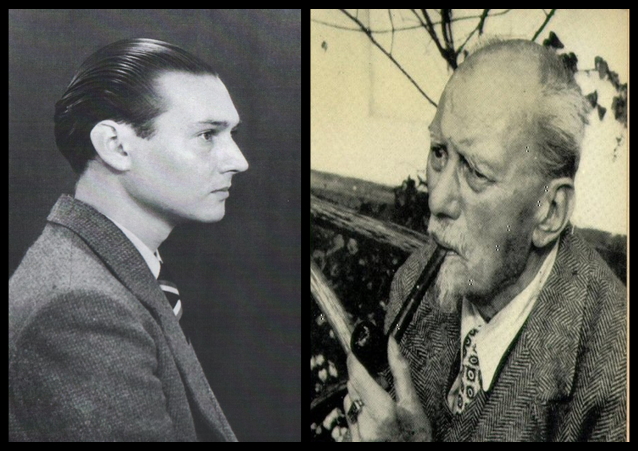
Above: Kenneth Grant & Aleister Crowley, c.1944.
S’lba was later identified as a ‘Goddess’ enthroned on the ‘planet’ beyond Pluto [=New Isis] from which the Trans-Yuggothian currents were broadcast.
The Wisdom of S’lba was received fragmentarily through various means, including ritual magic in which priestesses of the New Isis Lodge would become oracular. Then there was the long careful process of collating and arranging (and even an attempted interpretation, ‘The Qabalahs of Besqul’ – which is also included in Outer Gateways.)
Michael Staley’s contention is that such received texts are an upwelling of images from a continuum of consciousness, the collective unconscious:
“You might like to bring to mind the image of islands jutting up from an ocean – the more local areas, the shallows, are where we draw down inspiration from.”
Such inspiration is universal, cosmic, comes from the depths of consciousness “outside the human bandwith.”
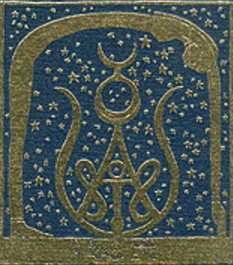
⊥
‘Against the Light: Kenneth Grant’s use of Imagination, Fiction, and Dreaming True’ by EMMA DOEVE.
Emma Doeve’s Work should be well known to readers of this blog, but of particular relevance here is the emphasis that Caroline Wise placed in her Introduction on Emma’s informed, insightful and intuitive Commentary on the Life & Work of both Kenneth Grant and Austin Osman Spare.
There is a secret ingredient to the Work of Kenneth Grant: Dreams & Dreaming. Drawing on the notion of ‘Dreaming True’ put forward in George Du Maurier’s debut novel, Peter Ibbetson – in which two lovers, unjustly separated, find through the strength of their desire they can imagine themselves into each other’s dreams and thus share a life together – then combining with the mechanism of building up the Magical Personality that Dion Fortune describes in her novels, to create the astral equivalent of the ‘composition of place’ put forward by St. Ignatius of Loyola in his Spiritual Exercises, that: “If you put yourself in a posture of prayer, you will feel like praying.”
Grant and his fellow initiates of the New Isis Lodge would significantly build on this, weaving a shared dream-world from the materials they drew from the pulp fictions and weird tales they so much enjoyed together, their beloved H. P. Lovecraft, Arthur Machen, Richard Marsh, Sax Rohmer and Bram Stoker.
As Grant says in the introduction to The Ninth Arch:
“When a lodge comprising skilled magicians dreams – that is, invokes – identical images in concentrated collectivity, the ensuing phenomena become a shared and vivid experience.”
In Against the Light, Grant creates a magical world, often quite a dark world. It is not for nothing that it is subtitled “A Nightside Narrative.” The narrator – “Kenneth Grant” – introduces us to an alleged uncle, the sinister Phineas Marsh Black, MD; an ancestor apparently burned at the stake for Witchcraft, Margaret Wyard; as well as the likes of Aleister Crowley, David Curwen the alchemist, mentions of Clanda the Water Witch from New Isis Lodge; and other members of his family who appear as characters, sometimes in quite startling aspects. Other elements that feed into the mix: Spare’s Spirit-Guide Black Eagle, Bram Stoker’s Dracula, Sax Rohmer’s dubious and sinister Orientals.

Right at the beginning we are introduced to the idea of a Grand Grimoire, or – with a play on words – the GRANT Grimoire, or Il Grimorio Grantiano, as this strangest of heirlooms is sometimes called, like their very own family Necronomicon! It materializes and de-materializes, it is found and then lost again, before being re-discovered, but it’s always hovering . . .
The Grant Grimoire weaves in and out, and gradually you realize that the novel itself is the Grimoire, a feat Grant pulls off by a dazzling sleight of hand, weaving into it his own dream material. The erotic imagination quickens the astral medium much more than just mundane daydreaming; how much more a magickally trained Imagination fuelled by Will, which can use the libido as a key to Dream Control.
Later in the book, Uncle Phin tells the narrator: “If you hold it against the light, an altogether different picture will emerge.” [The light from the Yesodic Aethyr almost solidifies at this point and so a bridge or perhaps tunnel materialises to the physical realm of Malkuth, perhaps even overspilling to what lies below, beneath and beyond. It is a time for Dreaming True.] As well as explaining the novel’s title, this passage introduces the kind of sleight of hand – or perhaps eye – that is central to Grant’s magic. The use of techniques that relate to Dali’s paranoia-critical method, Rimbaud’s “total and systematic derangement of all the senses”, and even Da Vinci’s mantic stain.
There’s no doubt that Kenneth Grant was a visionary, and like many such he makes a strong case for the origin of that Vision beginning in childhood’s wondrous apprehension of the numinous.
It is finally revealed that the ‘Primal Grimoire’ that was the source for all of this fascination with magic tales of exotic, far-off lands, and witches and wizards, was a children’s book with a picture of the Sphinx on the cover, much beloved of the young Kenneth Grant.
As the quote from W. B. Yeats at the beginning of the book puts it:
“There is some one myth for every man, which if we but knew it, would make us understand all that he did and thought.”
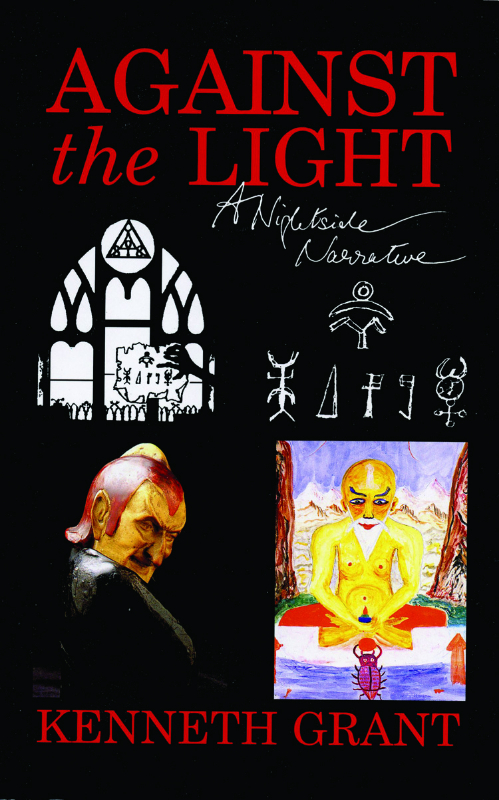
⊥
‘Grant, the Goddess, and a Visualization Journey’ by CAROLINE WISE.
Caroline Wise has worked for Psychic News, managed The Atlantis Bookshop, and also worked at Skoob Books, where she was instrumental in initiating the re-publication of the Work of Kenneth Grant. A longstanding member of the Fellowship of Isis, Caroline has also been a member of the Typhonian Order, and is now associated with Starfire Publishing with her husband, Michael Staley.
One thing unique to Kenneth Grant was his basic conception of Typhon – the monstrous and decidedly male Titan of Greek mythology – as FEMALE, a type of the primal Great Mother, and also that She is the Mother of Set – She is the Mother of the Child, the star-matter from which All things emerge.
He also conceived of Typhon as equivalent to the Egyptian Tauret, or Ta-Urt, the hippopotamus “Mistress of the Birth-House” – also a fierce mother protecting her young.
In Ancient Egypt, the Setian wands were made from hippo tusks, going back to shamanic origins.
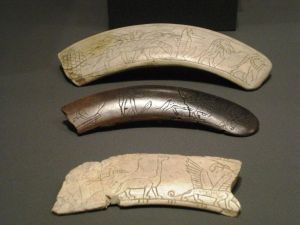
Many of these primal goddesses have as their avatars animals that can move between two realms: both Tauret and the frog-headed Hekt can move between land and water, and this is indicative of the starlit earth, the earth open to and receptive to the stars and cosmic radiations therefrom.
Infinite Stars and Infinite Space
If the Milky Way is seen as a glyph of Nuit, then the Great Rift of the constellation Cygnus (The Swan, ‘Hamsa’) equates to Her womb and vulva, from which the Sun is given birth – and many early cultures also believed it was where the soul went to when you died, and where it was also reborn from.
Before Caroline became involved (via Skoob Books) with the world of Kenneth Grant & the Typhonian O.T.O., she had joined the Fellowship of Isis. Most occult orders do not permit the joining of other groups, which was also true of the TOTO, but it seemed to make one exception for the FOI. Derry Robertson, who had co-founded the FOI with his sister, Olivia, had corresponded with Grant; they had exchanged books and he held him in high esteem, and had invited him to join the FOI – but Kenneth declined, saying he couldn’t join another spiritual order because he had his own to run – but he was always supportive of the FOI and wrote that he was “totally for the Goddess.”
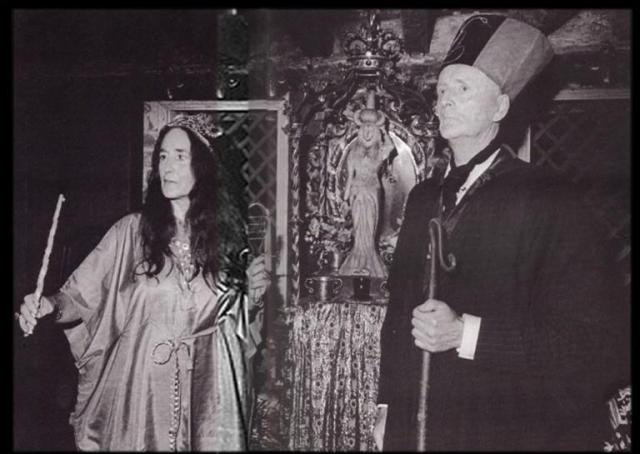
Above: Olivia & Lawrence Durdin-Robertson of the Fellowship of Isis.
Caroline described how when she was doing her probationary within the TOTO she was surprised by the similarity of the ritual structure for invoking the Goddess that Grant put forward to those of Olivia’s in the FOI.
Both Grant and Olivia Durdin Robertson felt strongly that the splitting of the atom and the dropping of The Bomb had changed Nature forever, created “a crack in the universe.” Olivia saw an ingress of Isis that would come and “sort us out” (her view was more optimistic), whereas Grant was more pessimistic about our possible fate – but that either way, the Incoming Current had to be prepared for and adapted to.
Kenneth Grant often talked about a Trans-Plutonic planet, and apparently in 1955 he wrote to the Royal Astronomical Society, asking if they had any knowledge of a planet “beyond Pluto” – which he referred to as “New-Isis.” They told him ‘No’ but mentioned that there was an asteroid, ‘42 Isis’, that had been discovered by English astronomer N. R. Pogson in 1856. Unfortunately, they neglected to tell Grant the correct date of Pogson’s discovery, so he never knew that it was in fact what would become his own birthday 68 years later, the 23rd of May!
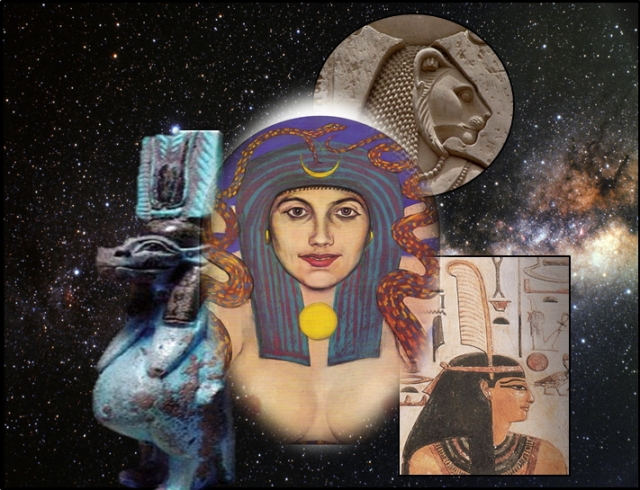
[In closing, Caroline led us all in a very moving Visualization, in which one ended up looking down into the Black Rift of the whirling Cosmos as if it was a gigantic scrying mirror of the Heavens, through which we were each invited to connect with the Goddess as the Primal Source.]
⊥
‘The Art of Steffi Grant and the Typhonian Tradition’ by HENRIK BOGDAN.
“Great art is always simple . . . true art expresses Eternity.” – Kenneth Grant, Aleister Crowley and the Hidden God.
Henrik mentioned that Art is essential to the function of the Typhonian Trilogies – that the text illustrated the pictures as much as the pictures illustrated the text. They totally complement each other. He then proceeded to treat us to a wonderful slideshow of the works of Steffi Grant, accompanied by some appropriate quotes about Art and Magick from Kenneth’s books.
In Outside the Circles of Time, Grant writes concerning Spare, Sime, Dali, Tanguy:
“These artists accomplished a leap into other dimensions and – this is the important point – returned to record their extra-dimensional experiences. This appears to be the crux of the matter, that certain artists entered another dimension and were permitted, or were able, to return to mundane consciousness and leave an account of the Vision. In days of antiquity this was known as the Vision of Pan.”
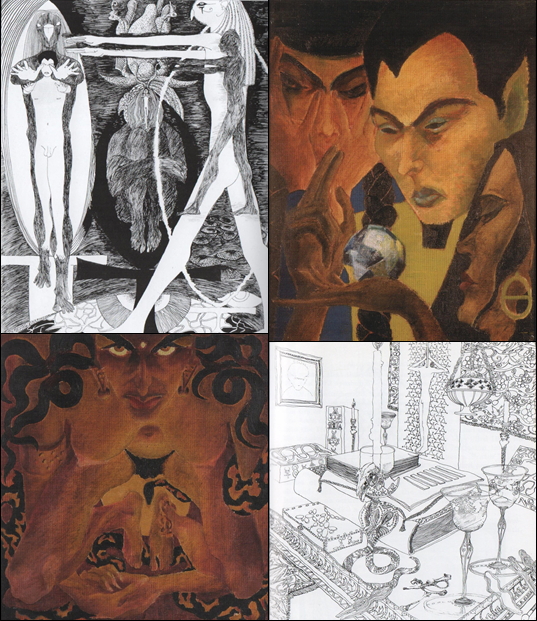
Above: Artwork by Steffi Grant – The Sign of the Enterer, The Mystic Eye, Shrine of Set, & Priestess of the Fire Snake.
Elsewhere, Grant also mentions the Surrealists Brauner and Delvaux (as well as of course in fiction and poetry Baudelaire, Huysmans, Lautréamont, Lovecraft, Machen, Mallarmé, Rimbaud . . .)
Great art speaks directly to the subconsciousness, and the true artist is able to access other dimensions.
Outside the Circles of Time, p.37: “Yet art, in the true and vital sense, is an instrument, a magical machine, a means of occult exploration which can project the seer into the realm of the Unseen, and launch the waking mind into the seas of the subconsciousness.”
Below: Steffi Grant, self-portrait
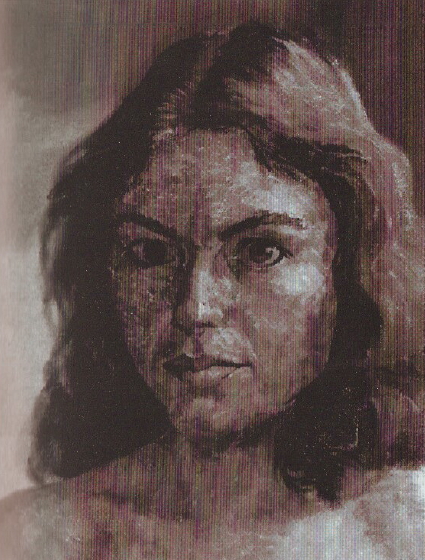
Kenneth Grant would use Art as a means of occult exploration, a gateway through which to enter the Mauve Zone. [We are reminded of an anecdote that Mogg Morgan shared after Grant’s death in 2011: “When I was in the OTO (his recension now renamed The Typhonian Order) I remember a friend sent him a book about the French Surrealist artist Yves Tanguy. KG’s eventual response was how much he enjoyed projecting himself into the artist’s creations – this says it all.”]
⊥
‘From Central Africa to the Mauve Zone: Gerald Massey’s Influence on Kenneth Grant’s idea of the Typhonian Tradition’ by CHRIS GIUDICE.
Christian Giudice is a doctrinal student in the Department of Literature History of Ideas and Religion, also at Gothenberg University. His particular interests include the influence of Aleister Crowley on later occultists, and influences on the work of Kenneth Grant.
Chris chose a difficult topic: the work of Gerald Massey (29th May 1828 – 29th October 1907), English poet and writer on Spiritualism and controversial ideas of Ancient Egypt, can be quite dry and rather heavy-going, but it is also an essential source for the ideas of Kenneth Grant and the basis of his ‘Typhonian Tradition’ – and he did an excellent job of making it more accessible and opening it up for a non-academic audience.
To introduce Massey’s ‘Egyptosophy’ ( = a pun on ‘Egypt’ and ‘Theosophy’ as his ideas cannot in any way be thought of as orthodox Egyptology), Chris started off by reading Massey’s poem from the opening of his 1,000-page magnum opus of 1907, Ancient Egypt: The Light of the World:
“It may have been a million years ago
The Light was kindled in the Old Dark Land
With which the illumined Scrolls are all aglow,
That Egypt gave us her mummied hand:
This was the secret of that subtle smile
Inscrutable upon the Sphinx’s face,
Now told from sea to sea, from isle to isle;
The revelation of the Old Dark Race;
Theirs was the wisdom of the Bee and Bird,
Ant, Tortoise, Beaver, working human-wise;
The ancient darkness spake with Egypt’s Word;
Hers was the primal message of the skies:
The Heavens are telling nightly of her glory,
And for all time Earth echoes her great story.”
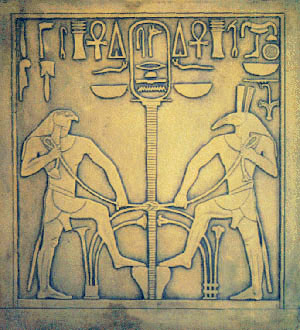
The Egyptian Mysteries form the core of the Western Magical Tradition.
Between 1898 and 1900, Aleister Crowley had learned most of what he would need as basis for his later development from his superiors in the Golden Dawn. Ancient Egypt as a source of supernatural power sanctioned his role as prophet.
Massey is the source for Kenneth Grant’s sense of the afrocentric and physiological basis of Gnosis – “The oldest symbols and religions originate in Africa” – as well as the Myths of the Origin of Typhon and the Birth of Set.
The mysteries transmitted to posterity were physiological in origin.
The Great Goddess was connected with the constellation of The Plough, Goddess of the Seven Stars of the North, Her son the Dog Star, Sothis or Sirius, whose heliacal rising appeared above the horizon just before the inundation of the Nile.
Ta-Urt, also known as Typhon, and Her son Sut or Set.
The term ‘Typhonian’ was used for those who worshipped the Primal Goddess.
Members of the Stellar Cult fled East, taking their wisdom with them, when the Solar worshippers gained the ascendancy.
“It was the god Set I was being called upon to honour . . .” wrote Grant in the Foreword for The Magical Revival (revised edition, Skoob 1991.)
Grant’s major innovation was to link the Typhonian Tradition to Modern Occultism.
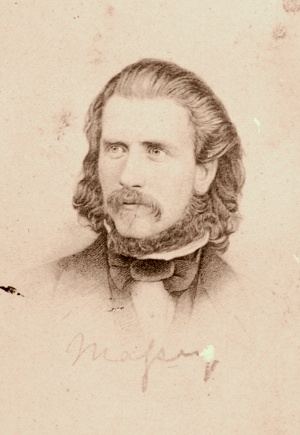
Above: Gerald Massey (29th May 1828 – 29th October 1907)
⊥
“All ‘others’ are merely forms of oneself” by EDWARD GAUNTLETT.
As well as a lifelong interest in Magick, Edward Gauntlett has studied literature, philosophy and religion to MA level, and is the author of the recently published Shades in Mauve: A History of the Typhonian Tradition (Von Zos, 2015.)
Edward opened with a reference to the Philip K. Dick novel, Do Androids Dream of Electric Sheep? – also the film loosely adapted from it, Blade Runner – with their shared central concern:
“When is a person really a person?”
He went on to mention the film, The Prestige, in which a character based on the inventor Nikola Tesla creates a kind of teleportation device, which works not just by beaming you across space but by producing replicants, resulting in the very real problem “How do you deal with the other one?”
He then posed a series of questions:
Is mind a product of the brain or is the physical universe a product of mind?
Does our consciousness arise from or consist of the projection of images? Creating the ‘illusion’ of the world?
Is consensus reality just a shared hallucination we all agree on?
All of which was interesting enough, but just sketched out the parameters of . . . something. It seemed like a collection of Notes in search of a Talk.
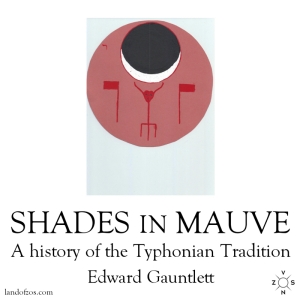
Edward then began a discussion of the condition of macular degeneration – how the deterioration in eyesight can result in hallucinations because the brain ‘fills in’ the gaps, before referring to H. P. Lovecraft’s short story, Hypnos, which opens with the following lines from another one of Kenneth Grant’s favourites, Baudelaire:
“Apropos of sleep, that sinister adventure of all our nights, we may say that men go to bed daily with an audacity that would be incomprehensible if we did not know that it is the result of ignorance of the danger.”
The ‘danger’ is fear / threat of the destruction of the ego
Ramsey Dukes, long before The Matrix, suggested we are already living in a computer-generated Virtual Reality.
Alexandra David-Neel and her tulpa-monk, Dion Fortune and her fenris-wolf: both started to take on objective existence, being seen by other people, and required some effort to be re-absorbed.
What appears to be the physical universe is only images in the mind, we can’t get beyond sensory data.
In closing, Edward summed up:
“The imagination as the image-making faculty is the supreme instrument of both magician and artist.”
⊥
After the Talk from Edward Gauntlett, there followed a further presentation from Henrik Bogdan, introducing his new book. We were treated to a slideshow giving an overview of the many different facets of the Work of Kenneth Grant – from his non-fiction and later fiction to a range of magazine articles, rare volumes of poetry, and also the various privately published documents of the New Isis Lodge and the Typhonian Order – accompanied by many rare and even previously unseen images, many of which are reproduced in Kenneth Grant: A Bibliography.
⊥
For further details about Kenneth Grant: A Bibliography, Outer Gateways, and all other titles by Kenneth Grant, please go to:
http://www.starfirepublishing.co.uk/

⊥

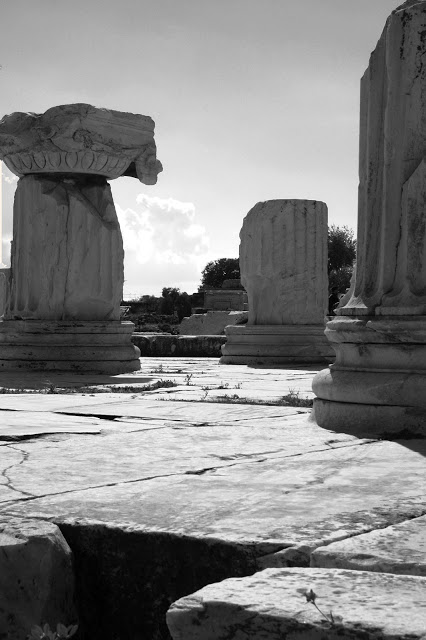
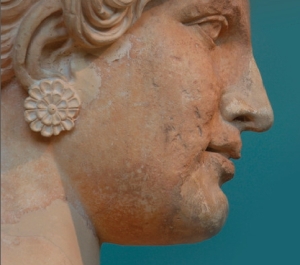
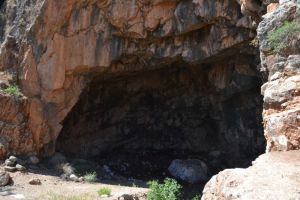
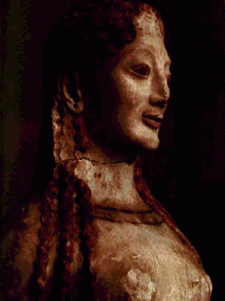

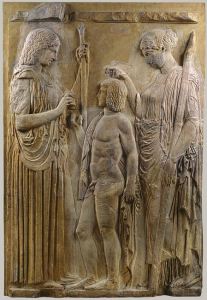

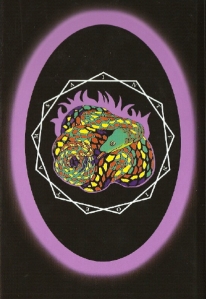
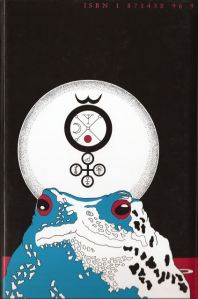

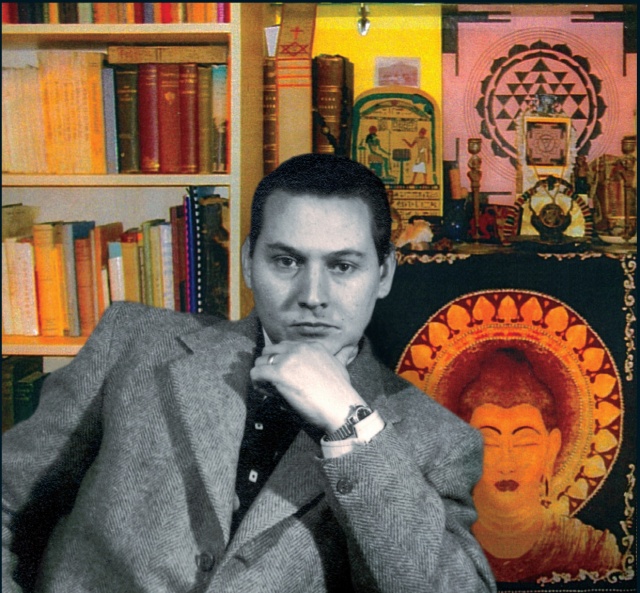
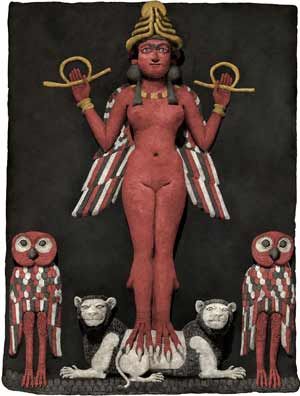
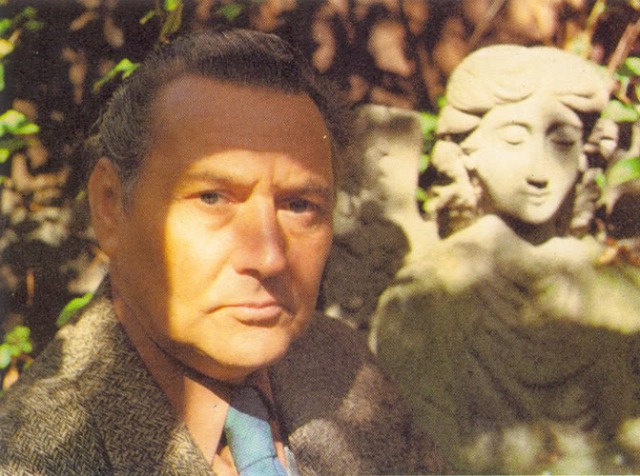
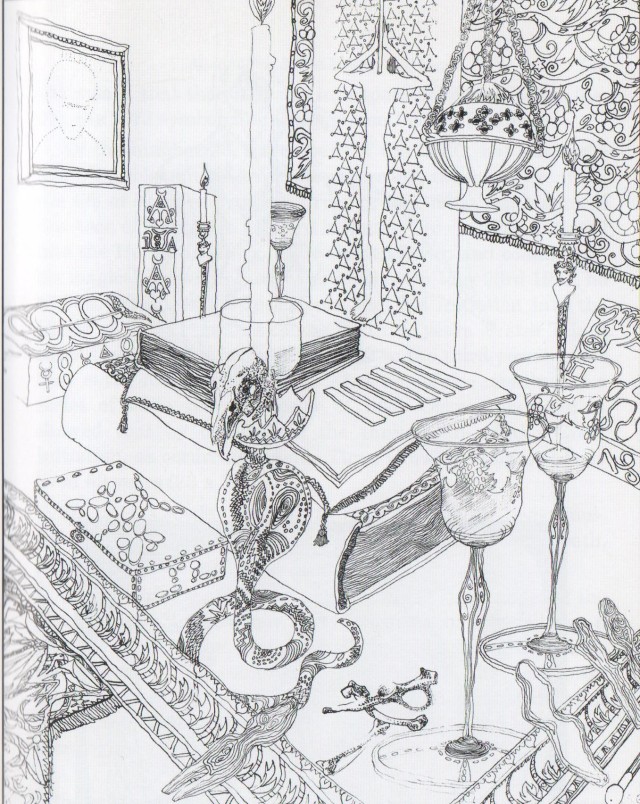

 Above: Typhonian Day Speakers, 9th January 2016. L-to-R: Henrik Bogdan, Edward Gauntlett, Chris Giudice, Michael Staley; in front: Emma Doeve, Caroline Wise. [Special Thanks to Matt Baldwin-Ives for the use of his photo.]
Above: Typhonian Day Speakers, 9th January 2016. L-to-R: Henrik Bogdan, Edward Gauntlett, Chris Giudice, Michael Staley; in front: Emma Doeve, Caroline Wise. [Special Thanks to Matt Baldwin-Ives for the use of his photo.]












